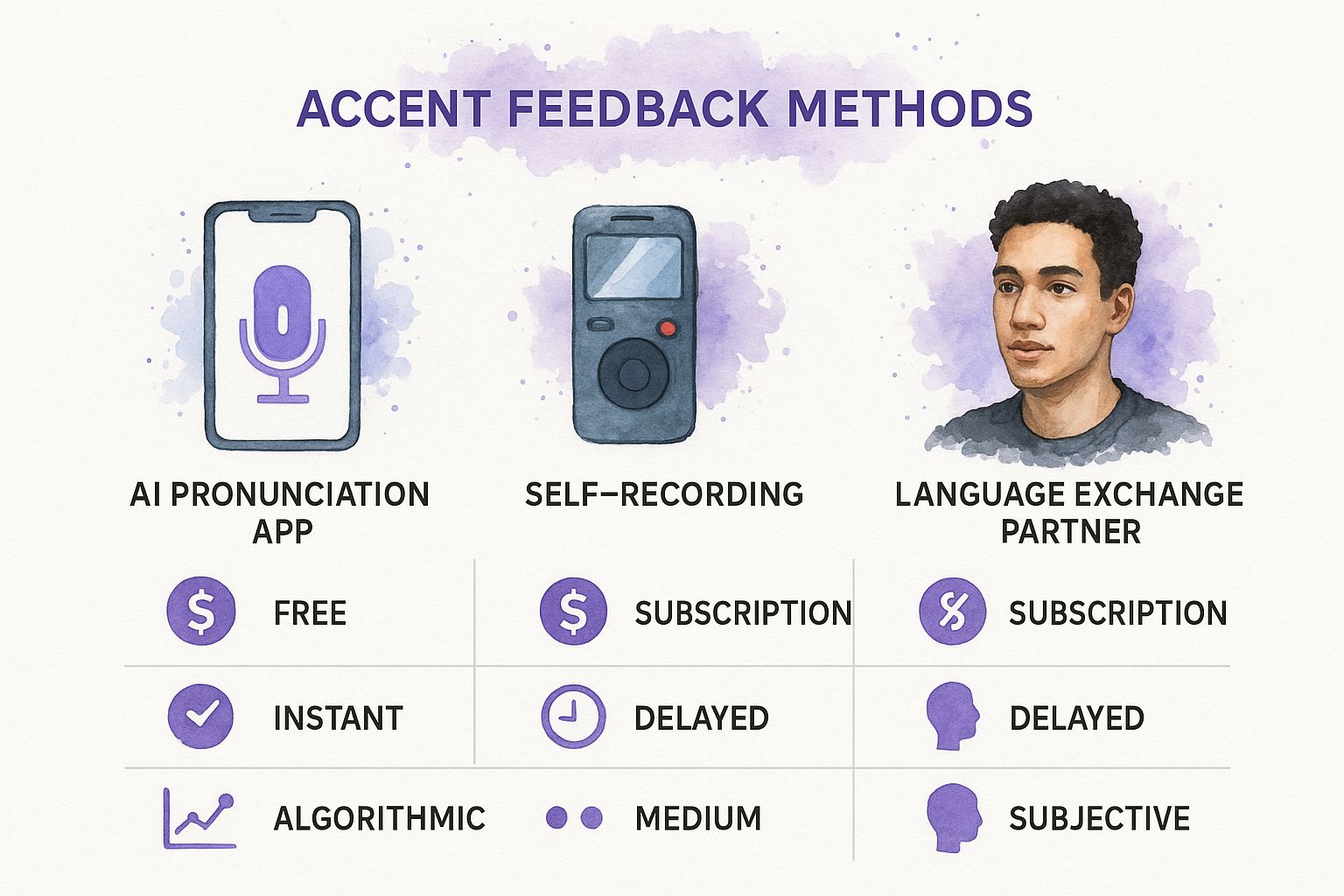How to Learn an English Accent: Your Practical Guide
Discover effective tips on how to learn an English accent quickly. Start mastering the accent today with our easy-to-follow guide!


If you're wondering how to learn an English accent, the first thing to realize is that it's a physical skill, much like learning to play the piano or swing a golf club. It’s all about muscle memory and training your ear, not just memorizing vocabulary. The real goal is to achieve clear, confident speech. We get there by breaking down sounds, getting a feel for the rhythm of the language, and, most importantly, listening and mimicking native speakers.
Think of it less like studying for a test and more like athletic training for your mouth.
Start Your English Accent Journey Here

Welcome! This is your hands-on guide to sounding more natural when you speak English. Let’s get one thing straight from the start: this isn't about erasing who you are or getting rid of your native accent. It's about adding a new tool to your communication belt.
The number one priority is clarity. You want people to understand you easily, without having to strain or ask you to repeat yourself. When that happens, your confidence soars, and conversations just feel easier.
There's a persistent myth that you can only get a "perfect" accent if you start as a kid. Sure, children are like sponges, but as an adult, you have a secret weapon: you can be strategic. You can consciously analyze how a sound is made, practice the specific mouth movements, and understand the why behind English speech patterns.
The Four Pillars of Accent Training
When I work with students, I always come back to four core skills. Mastering these provides a solid foundation for everything else you'll do. Think of them as the legs of the table—if one is weak, the whole thing is wobbly.
Here's a quick look at these "pillars" that form our roadmap for effective accent learning.
| Pillar | What It Is | Why It Matters |
|---|---|---|
| Listening | Active, analytical listening to hear the subtle sounds, rhythm, and intonation of native speakers. | You can't produce a sound you can't hear. This trains your ear to notice the nuances. |
| Understanding Sounds | Identifying and physically producing the specific vowel and consonant sounds of English. | This is the technical side—learning to make sounds that might not exist in your native language. |
| Mimicking | Directly imitating native speakers' pronunciation, word stress, and the "music" of their speech. | This retrains the muscles in your mouth, tongue, and jaw to move in new ways. |
| Feedback | Getting input on your pronunciation from a coach, an app, or by recording and analyzing yourself. | This is your reality check. It tells you what’s working and what needs more practice. |
These pillars give you a structured way to approach your practice sessions, ensuring you cover all the bases.
It's fascinating to think about the scale here. There are about 1.35 billion English speakers in the world, but only around 370 million of them are native. That means the majority of English conversations today happen between non-native speakers, which really drives home the need for clear, understandable communication. For more stats like this, Kylian.ai is a great resource.
I often tell my students to think of this process like learning a musical instrument. At first, your fingers—or in this case, your tongue and lips—feel clumsy and uncoordinated. But with consistent, focused practice, you build muscle memory. Soon, the movements become second nature.
Improving your accent is a huge part of becoming more fluent overall. The skills you build here will directly translate into smoother, more natural conversations. For some great exercises that connect pronunciation with real-world dialogue, our guide on English conversation for beginners is a perfect place to start applying what you learn.
Mastering the Core Sounds of English

To really nail a clear English accent, you have to get physical. Think of your mouth, tongue, and lips as your own personal sound studio. Right now, they’re perfectly tuned to produce the sounds of your native language. Learning an English accent is all about retraining those muscles to make new shapes and movements.
This whole process begins by isolating individual sounds, or what linguists call phonemes. Every language has a unique inventory of these sound building blocks. English has about 44 of them, and chances are, some will feel completely foreign to your mouth.
Our goal isn't just to know these sounds, but to build the muscle memory to produce them without even thinking about it.
Decoding Vowel and Consonant Sounds
Often, the biggest hurdles for learners are the subtle yet critical differences between English sounds. Take the short ‘i’ sound /ɪ/ in "ship" versus the long ‘ee’ sound /iː/ in "sheep." The difference seems small, but it can change the entire meaning of what you're saying. One sound is short and relaxed; the other is longer and requires you to spread your lips wider.
This is exactly where focused, deliberate practice makes all the difference. Let’s break down a few common challenges with tips you can use right away.
- The Tricky 'TH' Sound: A lot of languages simply don't have this sound. To make the voiceless 'th' (/θ/) in words like "think" or "three," lightly place the very tip of your tongue between your front teeth. Now, push air through that tiny gap—it should feel like a soft hiss.
- The American 'R' Sound: This one is tricky. Unlike a rolled 'r', the American 'r' (/ɹ/) is made in the middle of your mouth. Pull your tongue back and up so the sides touch your upper back teeth, but make sure the tip doesn't touch the roof of your mouth. Try it with words like "red," "car," and "thirty."
- The 'W' vs. 'V' Distinction: In languages like German or Russian, these two can sound almost identical. For 'w' (as in "we"), your lips need to form a small, tight circle. For 'v' (as in "very"), your top teeth should gently touch your bottom lip as you push the air out.
"The first step to producing a new sound is hearing it accurately. You can't fix a pronunciation mistake if your ear doesn't recognize it as a mistake in the first place. This is why active, focused listening is just as important as speaking practice."
Your Secret Weapon: The International Phonetic Alphabet
Trying to memorize lists of sounds is a surefire way to get overwhelmed. This is where a fantastic tool comes into play: the International Phonetic Alphabet (IPA). The IPA is a standardized system where every symbol represents one specific sound. No exceptions.
Think of it as a blueprint for pronunciation. When you see a word’s IPA transcription in a dictionary, you get an exact guide on how to say it, completely bypassing the confusing and inconsistent rules of English spelling. Learning even a few of the key symbols for sounds you struggle with can be a game-changer.
Practical Exercises for Sound Mastery
Knowing the theory is one thing, but putting it into practice is what actually builds the skill. Here are a couple of actionable exercises you can start today to retrain your mouth and master these core sounds.
Minimal Pair Drills
Minimal pairs are two words that differ by only a single sound, like "ship" and "sheep" or "sit" and "seat." Practicing these is one of the best ways to fine-tune both your listening and your speaking.
Make a list of pairs that target your specific problem sounds. Record yourself saying each word, then listen back. Can you really hear the difference?
| Target Sound | Word Pair 1 | Word Pair 2 | Word Pair 3 |
|---|---|---|---|
| Short 'i' vs. Long 'ee' | ship / sheep | sit / seat | live / leave |
| 'P' vs. 'B' | pig / big | pack / back | pull / bull |
| 'S' vs. 'Z' | seal / zeal | sink / zinc | price / prize |
Tongue Twisters
They might feel a bit silly, but tongue twisters are a phenomenal workout for your mouth. They force you to switch between difficult sounds quickly, which builds agility and control.
Start slow. The goal is accuracy, not speed. Once you can say it correctly, then you can gradually pick up the pace.
- For the 'th' sound: "I thought a thought, but the thought I thought wasn't the thought I thought I thought."
- For the 'r' sound: "Around the rugged rock the ragged rascal ran."
By consistently working on these foundational sounds, you're doing more than just learning to pronounce a few words. You're building the physical dexterity you need for fluent, natural-sounding speech—a crucial step on your accent journey.
Finding the Music in English Speech

Getting individual sounds right is a huge win, but it’s really only half the battle. If you’ve ever felt like your English sounds a little robotic or flat, even when you know you’re pronouncing words correctly, this is probably why. You're missing the "music."
This musical quality, what experts call prosody, is what breathes life into the language. It’s the combination of rhythm, stress, and melody that makes speech sound natural. A great accent isn't about hitting every single sound perfectly; it's about capturing the overall flow.
Think of it like playing the piano. You can play all the right notes, but without rhythm and feeling, it's just a sequence of sounds. It's not music. We need to shift your focus from single words to how they dance together in a sentence.
Unlocking the Rhythm with Sentence Stress
Here's a secret: in English, not all words get the same attention. Native speakers instinctively punch certain words and glide over others, creating a rhythm that's the very heartbeat of the language. This is called sentence stress.
The words that get the spotlight are what we call content words—they carry the real meaning. These are your heavy hitters:
- Nouns: (John, car, house, idea)
- Main Verbs: (runs, thinks, is eating, drove)
- Adjectives: (big, red, interesting, beautiful)
- Adverbs: (quickly, very, always, carefully)
On the flip side, function words are usually unstressed. They're the grammatical glue holding everything together (a, an, the, in, on, at, for, and, but, is, are, can, will).
Let’s see it in action. A learner might say every word with equal weight:
"I - went - to - the - store - for - some - milk."
But a native speaker makes it bounce:
"I WENT to the STORE for some MILK."
Can you feel that da-DUM-da-da-DUM-da-da-DUM rhythm? That's what you're aiming for. A great way to practice is to grab any sentence, find the content words, and then say it out loud, really exaggerating the stressed words until it feels natural.
The Rise and Fall of Intonation
Once you have the rhythm down, there's another layer of music to add: intonation. This is simply the rise and fall of your voice's pitch as you speak. It’s what adds emotional color and helps listeners understand your true meaning.
Getting the intonation right can completely change the message. For instance, a falling pitch usually signals a simple statement of fact.
- "You're going to the party." (Pitch falls at the end: ↘)
But if you make your pitch rise at the end, the same words suddenly become a question, maybe showing surprise or disbelief.
- "You're going to the party?" (Pitch rises at the end: ↗)
This is a game-changer. Intonation is how you convey sarcasm, excitement, doubt, or authority, often without changing a single word. A fantastic way to get a feel for this is to listen to short audio clips from movies or podcasts. Try to trace the speaker's pitch with your hand, moving it up and down as their voice changes.
The most effective way to internalize English intonation is through active listening. It’s not just about hearing the words, but about hearing the melody behind them.
This takes focused practice. Sharpening your listening skills will make you much more attuned to the subtle shifts in pitch that native speakers use automatically. For some specific exercises, check out our guide on how to improve English listening skills.
Creating Flow with Linking Sounds
The final piece of the puzzle is how native speakers make their speech so smooth and connected. In real, everyday conversation, words don't live on their own little islands. They blend together in a process called linking.
This is why spoken English can sound so incredibly fast to a learner. It’s not always about raw speed; it's about how seamlessly the words connect to one another. Here are the two most common ways this happens:
- Consonant to Vowel Linking: When a word ends with a consonant and the next one starts with a vowel, they mash together. "Turn off" becomes "tur-noff." "An apple" sounds more like "a-napple."
- Vowel to Vowel Linking: When one word ends in a vowel and the next also starts with a vowel, speakers often sneak in a tiny "w" or "y" sound to bridge the gap. So, "you are" becomes "you-ware," and "I am" sounds like "I-yam."
Practicing linking will make your speech flow beautifully. Try saying a phrase like "I want to pick it up" word by word. Now try it linked: "I-wan-tuh-pi-ki-tup." It feels weird at first, I know, but trust me—this is a huge step toward sounding genuinely fluent.
Putting Your Skills into Practice with Shadowing
Alright, you've started tuning your ear to the music of English and you've broken down some of the individual sounds. Now it's time to put it all together.
This is where the real work—and the real progress—begins. We're moving from just studying the theory to building a physical skill. Think of it like this: you've read the sheet music, and now you're going to actually play the instrument.
We’re going to focus on two incredibly powerful techniques: imitation and shadowing. They might sound similar, but they serve different, crucial purposes. Imitation is all about getting the details right, while shadowing is about building that natural, conversational flow.
Perfecting Your Pronunciation with Imitation
Imitation is your high-definition, slow-motion replay tool. The goal isn't to talk for a long time; it's to perfectly copy a very short piece of audio. It’s a laser-focused drill designed to match a native speaker's pronunciation, stress, and intonation as closely as humanly possible.
Here’s a simple, effective way to get started:
- Find a short clip. A single line from a movie, a sentence from a TED Talk, or a snippet from an audiobook is perfect. Keep it to one or two sentences.
- Listen like a detective. Play the line over and over. Don't just hear the words—listen for the music. Where does the speaker's voice rise and fall? Which words are emphasized? Which ones are rushed?
- Record yourself. Now, use the voice memo app on your phone and record yourself saying the exact same line.
- Compare and contrast. Play the original clip, then immediately play your version. The difference can be a real eye-opener.
- Refine and repeat. What did you notice? Was your "th" sound a bit off? Did you stress the wrong word? Tweak your pronunciation and record it again. Do this three or four times for the same line until you get remarkably close.
This exercise forces you to stop being a passive listener and become an active analyst of speech. It’s intense, for sure, but it produces rapid improvements in your clarity.
Building Natural Flow with Shadowing
If imitation is like looking through a microscope, shadowing is like a full-body workout. The technique is simple: you listen to a native speaker and speak along with them in real-time, just a split second behind.
The key here is not to stop and correct yourself. Just keep going. You're trying to match the speaker's overall pace and rhythm.
The magic of shadowing is that it helps you bypass the part of your brain that overthinks every little grammar rule and sound. Instead, you're building muscle memory. You’re training your mouth to produce the sounds and rhythms of English instinctively, without having to think about it.
Shadowing is less about perfect pronunciation and more about absorbing the natural flow of the language. You're learning to feel the rhythm in your bones, not just understand it in your head.
Think of it as learning to dance by following your partner's lead. You don't stop to analyze every step; you just move with them.
Podcasts or interviews are fantastic for shadowing practice because the speech is natural and unscripted. This is one of the best ways to internalize the linking, stress, and intonation patterns we've been talking about. You can find more tips on this in our guide to English conversation practice online.
This kind of active immersion is a powerful accelerator. Just look at the historical data: between 1900 and 1930, about 86% of immigrants to the United States learned to speak English. That number climbed to 91% for immigrants between 1980 and 2010. It just goes to show a timeless truth: to really learn an English accent, you have to surround yourself with it. You can dig into more of this fascinating data from the Cato Institute's research on the topic.
Your Practice Checklist
To keep your practice focused, it helps to have a quick checklist. After each session, ask yourself these questions:
- Rhythm Check: Did my sentence stress match the speaker's?
- Melody Check: Was my intonation (the rise and fall of my voice) similar?
- Sound Check: Did I nail the specific vowel or consonant I was working on?
- Flow Check: Did I link my words together smoothly, like the speaker did?
By combining precise imitation drills with immersive shadowing practice, you create a balanced routine. You'll be fine-tuning the small details while building the fluid, natural rhythm that makes an accent sound truly authentic.
How to Get Feedback and Track Your Progress
You can’t fix what you can’t hear. It’s a simple truth that often gets overlooked. While practicing is crucial, you could just be reinforcing the same mistakes without a way to check your progress. This is where a solid feedback loop comes in—it's the single most important part of shifting from conscious effort to natural, automatic fluency.
Getting good feedback doesn't mean you have to hire a private coach, either. Some of the best tools are probably sitting in your pocket right now. Building a practice that actually sticks is all about learning to listen to yourself with an objective ear, pinpointing what needs work, and celebrating those small wins along the way.
Creating Your Own Feedback Loop
The easiest place to start? Your phone’s voice recorder. Seriously. It's an incredibly powerful tool for self-correction.
Just record yourself reading a paragraph from a book or an article, then play it back. When you listen, don't just hunt for mistakes. Pay attention to the rhythm, the way sounds link together, and your intonation patterns.
Hearing your own voice on a recording can feel a bit strange at first, but it's the most direct way to compare the sound you think you're making with the sound you're actually making. That objective perspective is where the real learning happens.
This simple act of recording and reviewing creates an immediate feedback loop. You become your own accent coach, training your ear to catch the very nuances you're working so hard to master.
Leveraging Technology for Instant Feedback
Beyond just recording yourself, technology can offer some pretty amazing data-driven feedback. AI-powered pronunciation apps are designed to give you instant scores, breaking down your speech sound by sound. Many can even highlight the specific phonemes you struggle with, giving you a clear roadmap for what to practice next.
Let's look at how the common feedback methods stack up.

As you can see, there isn't one "best" method. The ideal approach often involves a mix of all three, depending on your goals and budget. Another fantastic option is finding a language exchange partner—a native speaker who wants to learn your language. Their feedback might be less clinical than an AI's, but they can give you priceless insights into what sounds truly natural in a real-world conversation.
Feedback Method Comparison
Choosing the right feedback method depends entirely on your budget, how much time you have, and your personal learning style. Here’s a quick breakdown to help you decide what combination might work best for you.
| Method | Pros | Cons | Best For |
|---|---|---|---|
| Self-Recording | Completely free, always available, great for self-awareness. | Can be hard to spot your own mistakes, lacks outside perspective. | Foundational practice and building your listening skills. |
| AI Pronunciation Apps | Instant, objective feedback; targets specific sounds. | Can feel impersonal, may not catch nuances of natural speech. | Targeted phonetic drills and quick, daily practice sessions. |
| Language Exchange Partner | Real-world conversational practice, cultural insights, builds confidence. | Feedback can be subjective, scheduling can be tricky. | Learners who want to test their skills in a natural, conversational setting. |
Ultimately, combining these methods gives you the most well-rounded approach. Use an app for daily drills, record yourself to track progress, and meet with a partner to put it all into practice.
How to Ask for and Use Feedback
To get genuinely useful pointers from a language partner, you have to ask the right questions. A vague "How was my accent?" won't get you very far.
Instead, try getting specific:
- "Was there any word in that last sentence that sounded a little off to you?"
- "From my intonation, could you tell I was asking a question?"
- "I'm really working on my 'th' sound. How did the word 'three' sound just now?"
This approach gives your partner something specific to listen for and gives you actionable advice you can use immediately. Keep track of these small adjustments in a notebook or a digital document. Over time, you’ll build a clear record of your progress, which is one of the best motivators out there.
The demand for clear English communication is exploding worldwide. In many emerging markets, enrollment in English learning is jumping by over 20% each year, all thanks to clear economic benefits. Speakers with fluent English can earn up to 30% more, which shows the real, tangible value of this investment. You can discover more insights about these global English trends to see the bigger picture.
By consistently seeking and applying feedback, you turn every conversation into a chance to learn, which will massively speed up your journey to speaking English clearly and confidently.
Got Questions About Learning an English Accent? You're Not Alone.
As you start working on your accent, a bunch of questions are bound to pop up. It's totally normal. Let's tackle some of the most common ones I hear from learners, so you can move forward with clarity.
How Long Does It Take to Learn an English Accent?
Honestly, there's no magic number here. It's less like a race with a clear finish line and more like getting in shape—it's an ongoing process of refinement and getting stronger.
How fast you progress really depends on a few things: your native language, how often you practice, and what your personal goals are. But with 30-60 minutes of focused practice every day, most people start to notice a real difference in their clarity and confidence within about three to six months.
The real goal isn't to hit some imaginary deadline for perfection. It’s about clear communication and steady progress. Celebrate the small victories, like when a native speaker understands you without a hitch.
American or British—Which English Accent Should I Learn?
The "best" accent is simply the one that makes the most sense for you. Neither one is superior; they're just different sound systems with their own unique music.
If you're planning to work or live in the U.S. or Canada, a General American accent is probably your best bet. On the other hand, if your world revolves more around the UK or parts of Europe, what's often called "Standard British English" (a modern version of Received Pronunciation) might serve you better.
The most important thing? Pick one and stick with it. Bouncing between the two will just confuse your mouth and your brain, slowing you down. Consistency is what builds the muscle memory you need.
Is It Possible to Completely Lose My Native Accent?
I'd suggest reframing this. Think of it as adding a new accent to your toolkit, not losing your original one. While a few adult learners manage to sound almost native, it's incredibly rare and takes an enormous amount of work.
Your accent is a part of who you are—it tells your story. The goal shouldn't be to erase your identity, but to refine your speech so that you can be understood easily by anyone. Focus on clear, confident communication, not on eliminating every trace of your linguistic heritage.
Can I Learn an Accent Just by Watching Movies?
Watching movies and TV shows is a fantastic supplement, but it can't be your whole strategy. It’s brilliant for passive listening, which helps your brain soak up the natural rhythm, melody, and flow of spoken English.
But to see real, lasting change, you have to pair that passive listening with active practice. Just watching isn't enough to retrain your muscles.
Turn that screen time into a powerful workout for your mouth:
- Mimicry: Pause on a single line of dialogue. Try to copy the actor's pronunciation, stress, and intonation as precisely as you can. Record yourself and compare.
- Shadowing: This is a bit more advanced. Try speaking along with the actors in real-time. It’s a fantastic way to internalize their speech patterns and build fluency.
It’s this kind of active work that transforms passive viewing into a powerful learning tool.
Ready to move from watching to actually speaking with confidence? TalkEasy provides the active practice you need to make real progress. Get instant feedback on your pronunciation with our AI tutor in just 15 minutes a day, and build real-world fluency faster than you thought possible. Start your journey to clearer, more natural English by visiting https://www.talk-easy.com today.